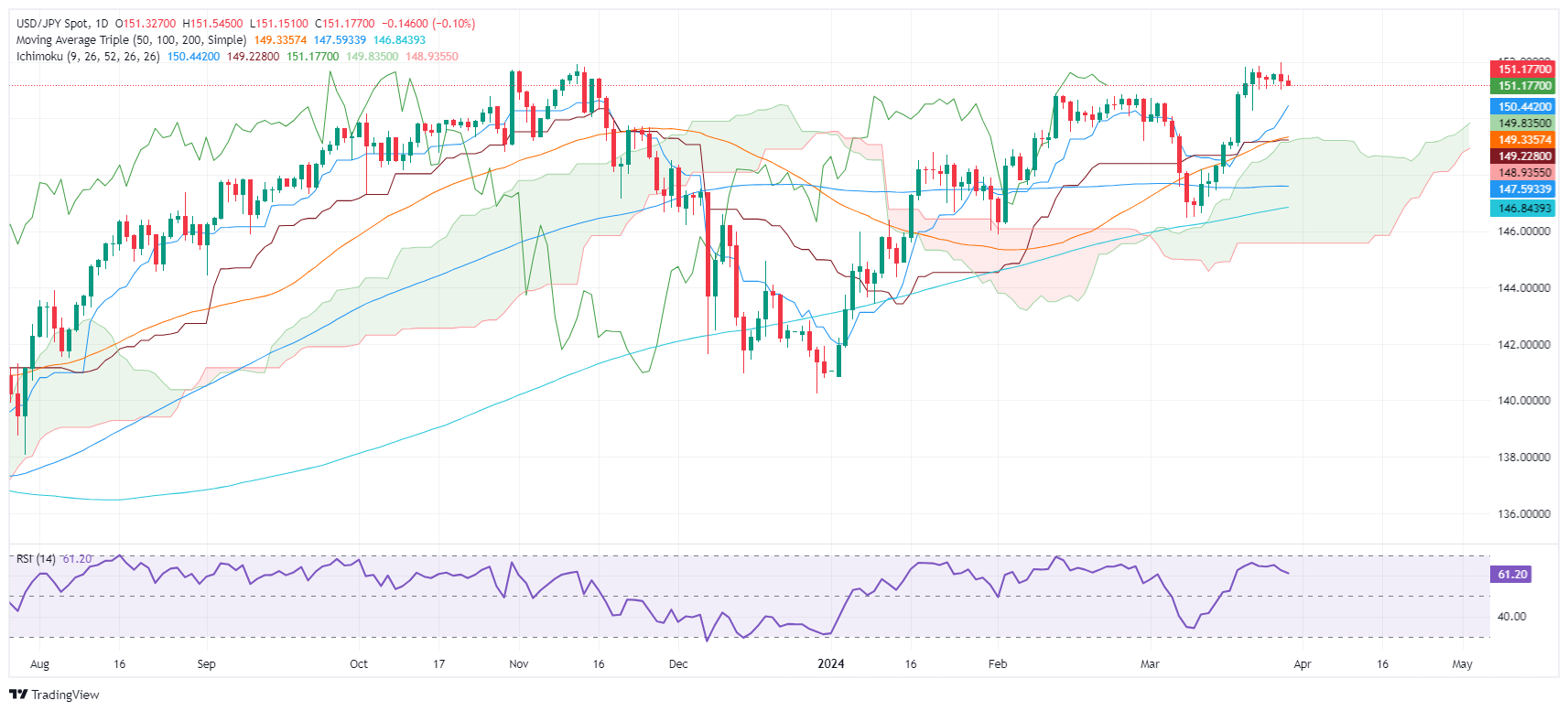- The USD/JPY pair remains at 151.28, with traders wary of possible Japanese intervention in the market supporting the Yen.
- US GDP growth in the fourth quarter beats expectations at 3.4%, while jobless claims and consumer sentiment indicate a robust economy.
- Fed Governor Waller's hawkish stance underscores the need for sustained inflation progress, weighing on rate cut expectations.
USD/JPY remains subdued during the North American session, trading at 151.28, almost sideways, amid renewed fears that Japan will intervene in the markets to curb the weakness of the Japanese Yen (JPY).
USD/JPY trades cautiously, with US economic growth and employment data in focus, along with intervention warnings from Japan
Market sentiment is mixed amid illiquid trading as the first quarter of the year ends. US economic data revealed that the country grew 3.4% in the last quarter of 2023, surpassing the preliminary reading of 3.2%, according to the Bureau of Economic Analysis. Meanwhile, quarterly inflation measures reached the Federal Reserve's (Fed) 2% target,
Other data showed that initial jobless claims for the week ending March 23 fell short of market expectations for an increase of 215,000 and stood at 210,000, down from the previous week. The data shows that the labor market remains tight, which could deter the Fed from cutting rates.
At the same time, the University of Michigan Consumer Sentiment Index rose to its highest level since July 2021, sitting at 79.4, beating estimates of 76.5. Pending home sales rebounded in February, rising 1.6% month-over-month after plunging -4.7% in January and above the consensus of 1.5%.
On Wednesday, Fed Governor Christopher Waller made some hawkish statements. He stated that rates have to rise for longer than expected and that further progress in inflation is necessary before supporting a rate cut. In his opinion, the start of the easing cycle will occur in 2024, although he suggests that consecutive months of inflation data that are at 2% are needed.
On the Japanese front, the Bank of Japan's summary of views revealed that members said that yield curve control, negative interest rates and other stimulus measures did their job. Meanwhile, verbal intervention by Japanese authorities discouraged traders from opening new long bets on the USD/JPY pair amid threats of intervention.
USD/JPY Price Analysis: Technical Outlook
The daily chart suggests that USD/JPY has peaked around the 151.20/151.90 area, although the bullish bias remains. A clear break above 152.00 could pave the way to challenge 153.00. On the other hand, if the sellers push the exchange rate below 151.00, a pullback would occur, and the Tenkan/Sen would be the first support at 150.44, followed by 150.00 and the Senkou Span A at 149.84.

Japanese Yen FAQ
The Japanese yen (JPY) is one of the most traded currencies in the world. Its value is determined broadly by the performance of the Japanese economy, but more specifically by the policy of the Bank of Japan, the differential between the yield of Japanese bonds and that of US bonds, or the risk sentiment of traders. , Inter alia.
One of the Bank of Japan's mandates is currency control, so its movements are key for the yen. The BoJ has intervened directly in currency markets on some occasions, usually to lower the value of the yen, although it often refrains from doing so due to political concerns among its major trading partners. The BoJ's current ultra-loose monetary policy, based on massive stimulus to the economy, has caused the yen to depreciate against its major peers. This process has been exacerbated more recently by a growing policy divergence between the Bank of Japan and the other major central banks, which have chosen to sharply increase interest rates to combat inflation levels that are at their highest levels for decades.
The BoJ's stance of maintaining ultra-loose monetary policy has led to an increase in policy divergence with other central banks, particularly the US Federal Reserve. This supports a widening of the spread between US and Japanese bonds to 10 years, which favors the US Dollar against the Japanese Yen.
The Japanese yen is often considered a safe haven investment. This means that in times of market stress, investors are more likely to put their money in the Japanese currency due to its supposed reliability and stability. In turbulent times, the yen is likely to appreciate against other currencies that are considered riskier to invest in.
Source: Fx Street
I am Joshua Winder, a senior-level journalist and editor at World Stock Market. I specialize in covering news related to the stock market and economic trends. With more than 8 years of experience in this field, I have become an expert in financial reporting.







